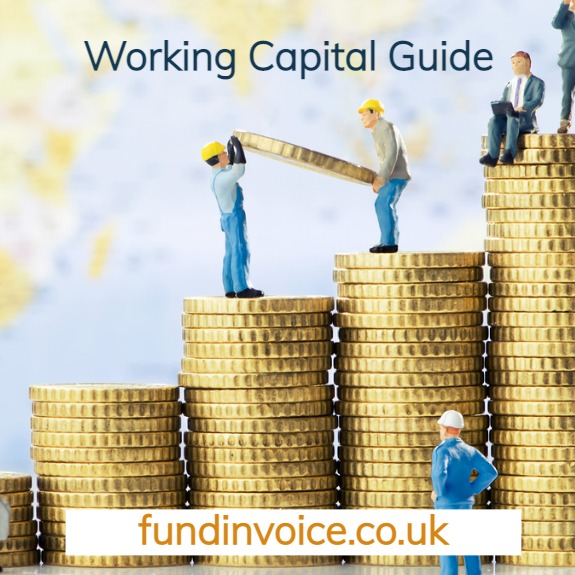- 21 Nov
Working Capital Guide

Working capital (WC) is vital for every business. This is the money you have available within the business to pay your liabilities as they fall due. If you run out of WC, you will not be able to meet your obligations, and this could be a major issue. Worst case, this could lead to the business's failure.
RUN A FREE CASH FLOW HEALTH CHECK
Working Capital Guide
This guide to working capital explains what working capital is, how to keep track of your current position and how to raise additional working capital should you need it.
What Is The Working Capital Formula & Ratio
There is an accounting formula to work out your working capital position. Very simply, from your financial accounts, you can make the following calculation -
- Working Capital = Current Assets - Current Liabilities
The Working Capital Ratio (also called the Current Ratio) would be the expression of those current liabilities as a fraction or percentage of your current assets. To calculate it, you would divide total current assets by total current liabilities (current means those due within a year).
Limitations
You may immediately identify some limitations in that formulaic approach.
Age Of The Underlying Figures - Firstly, using your financial accounts at year-end will only tell you the position as it was at your year-end. Even using your management accounts may still only prove slightly more helpful. For example, they may also be out of date by a matter of days, weeks or even months.
Alternatively, you might choose to calculate the figures on a more regular basis yourself by taking into account factors such as the cash that you currently hold in your bank account and the creditor payments that are falling due.
Conversion Of Current Assets To Cash - Another limitation is that this calculation can include current assets, such as stock or raw materials, that might not easily convert into cash. Stock inventory needs to be sold and paid for in order to convert into cash. Also, your debtor book of outstanding sales invoices may take time to convert into cash. Typically, customers in the UK will tend to take a 30-day credit period as a minimum.
You may choose to leave out some of these asset classes when assessing your WC position if you want to be on the safe side, and only consider, say, cash in hand and debtor monies you are expecting to be paid imminently.
How To Raise More Working Capital
If you need to raise more working capital, there are a number of ways to do that. You could -
- Speed up the conversion of assets into cash - this could include improving your debtor credit control to get paid more quickly (see the comments above about how the limitations of including all current assets in your calculations).
- Seek new investment into your business - this may be an option using either your funds or those of external investors. The drawback with new investment is often that you have to concede part of the ownership and control of your business.
- Seek new financing - taking out new business finance could generate an additional amount of capital for your business to use.
- Drive down your costs - this could reduce your need for WC. You might try shopping around alternative suppliers to seek discounts or improved payment terms. There may be other liabilities that you could manage without, see our Guide To Company Cash Flow for some ideas on how to tackle your costs.
Sources Of Financing
Some of the sources of the new financing will include bank funding, such as an overdraft or a bank loan. Business loans can also be made available by other independent loan companies rather than a bank. This may be helpful if your circumstances have led you to be declined for funding by a bank.
Alternatively, receivables financing is another good option to raise more working capital. It works by unlocking the funds that are tied up in your unpaid accounts receivable. Stock finance can be used to release cash from your stockholdings or raw materials.
Guide To Working Capital
Hopefully, this guide to working capital has been useful in pointing you towards the various resources that may help. These should assist you in better understanding your position and the options available should you need to raise more working capital.
- Home
- Business Financing
- Invoice Finance
- Invoice Discounting
- Factoring
- Debt Factoring
- Recourse Factoring
- Fund Selected Invoices
- Business Loans
- Construction Sector Funding
- Protect Against Bad Debts
- Exports Collection And Funding
- Import Funding
- Body Shop Funding
- Spot Factoring
- Retail Sector Funding
- Fund Invoices Confidentially
- Help Running Your Payroll
- CHOCs Customer Handles Own Collections
- Collect Invoices Confidentially And Funding
- Outsourcing Your Credit Control
- Asset Finance And Mortgages
- Case Studies
- About Us
- Testimonials
- Find Out More
- News
- Free Magazine
- Blog






